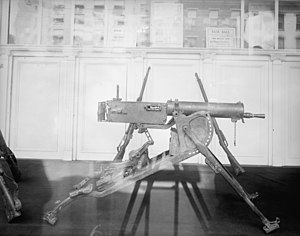Semi automatic rifles, for the role of the typical infantry rifleman, ARE superior to bolt actions. Higher rates of fire, detachable magazines, ability to keep your sights on target without having to cycle the bolt, etc. These are all general improvments for the rifleman role. That's what Oldih was talking about. Obviously most of the world's armed forces agree, as I can't think of any country outside of the bottom of the barrel that arms their troops with bolt actions anymore.
Righto.
Hey, bro, what's this?
Well what the **** do you know, a detachable box magazine on a bolt-action rifle.
"Higher rates of fire, ability to keep your sights on target without having to cycle the bolt"
Decent trade-offs for immaculate reliability and accuracy (which was significantly more pronounced in World War II as you well know). Or these reasons:
"The integral strength of the design means very powerful magnum cartridges can be chambered without significantly increasing the size or weight of the weapon. For example, some of the most powerful
elephant rifles are in the same weight range (7-10 lbs.) as a typical [semi automatic] [...] By contrast, [...] the operating mechanism of a semi-automatic weapon must increase in mass and weight as the cartridge it fires increases in power. This means that semi-automatic rifles firing magnum cartridges, while they do exist, tend to be relatively heavy."
(Wiki)
I.E. superior "power"-to-weight ratio.
It's also worth noting, I think, that the tighter the tolerances of a semi-automatic or automatic firearm, the greater the unreliability of the operation generally. An AK-47, for example, can maintain pristine firing operation under virtually any conditions, whereas the M-16 cries when you don't clean it frequently and keep it out of harm's way. But then again, the M-16 can sustain a far smaller grouping of shots at a far longer range than the AK-47 can. High tolerance, low tolerance.
Excuse me, that's not going to cut it. Name one other reason and I'll give you a PRIZE.
But at any rate you say effectively that because the semi automatic has a higher fire rate than the bolt-action rifle that suddenly it's superior despite the drawbacks I mentioned. So I submit to you that the superior weapon has been around for long prior to the semi-automatic rifle. I submit to you:
The macheeeeeengun:
Ooooh, wow. This machinegun has a whopping firerate of 400 rounds per minute which by your sole criterion should make it more than capable of *****slapping any semi-automatic rifle. Sure, it can only be fired from a stationary position, but it fires really fast!
Or perhaps the machinepistol:
This has a fire rate of over 500 RPM and due to the small cartridge is capable of sustained controllability despite the high fire rate, far more controllable than any rifle. Sure, it carries a pistol cartridge leading to short range, low velocities, penetration, and accuracy, but it fires really quickly.
At any rate I hope I've demonstrated to some extent that a weapon's utility is generally based on its ability to fulfill a given role. As a matter of fact, modern armies largely do not use semi-automatic rifles. They use assault rifles or in many cases battle rifles. As a matter of fact lots of insurgents and terrorist groups have for many years used assault rifles along with backstock of bolt-action rifles. One reason both modern armies and resistance groups use these weapons is that they are incredibly utilitarian weapons with great versatility....in the general combat role they provide the option for fully automatic fire for close quarters combat, sustained suppressive fire for medium-range targets, and accurate, precision fire at intermediate ranges. Granted, most of them are totally useless past 300 meters with open sights, that's why most militaries of the world use highly accurized marksman-class semi-automatic rifles for engaging targets at long distances or bolt-action rifles or anti-materiel rifles for engaging targets past 600 meters.
Weapons are not one-size-fits-all. Semi-automatic rifles are very efficient means of engaging medium to long-range targets insofar as they can chamber high-caliber rounds with more than adequate accuracy, but when total precision is required modern armies still fall back on the reliable bolt-action rifle.
To your concern about bolt-actions being inadequate for the rifleman position....I merely point to the title of the thread, which refers specifically to the sniper role.
And I also suggest you read the caption to the semi-automatic rifleman position in Red Orchestra Ost Front, which suggests that the SVT-40 was issued in limited numbers to Strelok in World War 2 as a result of its complicated operation and difficult maintenance. Or perhaps you could read up on the Gewehr 41, the initial failed attempt by the German arms designers to supplant the K98 with a semi-automatic rifle. Or perhaps you could simply play Ost Front's sniper role equipped with an SVT-40 or a G-43 and notice the gargantuan spread of both rifles, particularly when compared to old reliable, the MN91/30 and Kar98k.
Are bolt-action rifles outdated? In a manner of speaking....they are certainly inadequate in many roles, in particular close-quarters and trench cleaning, or supplying significant volume of suppressive fire, but they are utterly fantastic weapons when all you need is to hit the target and watch him fall over dead in the first shot.
I can't tell you how many times I rushed out into battle with my spiffy STG-44 in Ost Front only to find myself wishing I had a Kar98k to engage targets perched in a sniper nest or reach out and touch enemies over vast distances. Make no mistake, if you don't miss and you have enough time or enough cover to bolt your rifle, the bolt-action doesn't make any mistakes.








